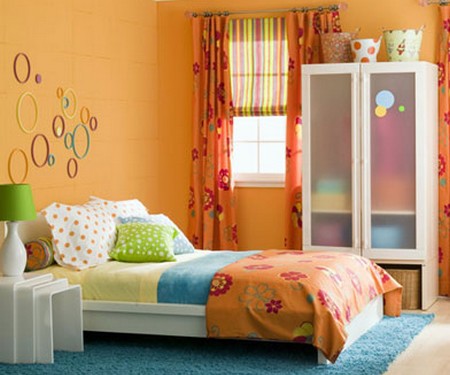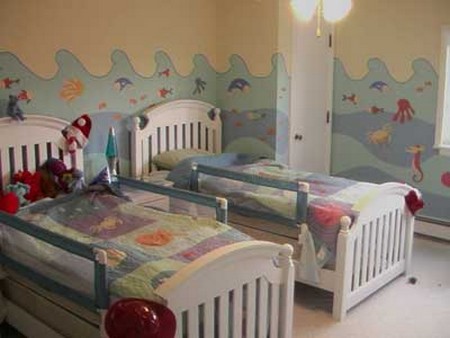The day of the formal nursery is past but, where possible, the new baby should have a room to himself, which in time can double as a playroom. The aim should be to provide a clean, airy room that is safe for its occupant. In the early months when the baby is confined to his cot there is little danger, but, once he begins to crawl, all sorts of hazards are to be found.
Parents usually re-decorate the room intended for the new baby; high gloss or washable paints and vinyl wallpapers are good choices as they are easily cleaned of grubby finger marks. A blackboard or an area of wall covered with formica gives the small child somewhere to draw and scribble as he wishes. The floor needs a covering as splinters from a wooden floor are dangerous when the child is crawling; linoleum or lino tiles are safe and colourful and many of the new synthetic materials are both soft and warm to the knees. If rugs are used, they should be bright, washable and, above all, non-slip. Curtains too should be washable, and can be bright and colourful.
Ventilation is important and should be achieved without draughts. As the child grows you should take care to see that he cannot open a window himself nor fall out of one opened by you. Lighting should be adequate, but switches should be out of reach of small fingers and trailing flexes made inaccessible. Toddlers will push things into electric sockets: it is essential to put a plug into an empty socket even if it is unconnected to any equipment, or cover it with a specially designed safety socket cover, which are cheap to buy.
Heating is essential, especially for the newborn who may become severely chilled ‘f the temperature drops at night. Central heating, oil-filled electric radiators or night storage heaters are probably the safest forms of heating but unfortunately are not aways available. All fires should be adequately guarded. Gas fires may be dangerous if the flames blow out; ensure regular servicing and adequate ventilation, as they can also cause condensation. Paraffin oil heaters should be avoided or used with great care as they account for innumerable deaths from fire each year among babies and children.
Selecting furniture
For the first few weeks of life a carry-cot is often the most useful and convenient item of baby’s furniture, as it can be carried everywhere and the new baby put to sleep in it during the day as well as at night. If it has a waterproof hood and cover you will be able to take the baby out in the rain. If it comes with a stand and wheels it can double as a pram. Alternatively you may like to use a basket with handles. Although lighter and easier to carry than a carry-cot, such baskets are not waterproof and therefore not very practical for outdoor use.
As well as being convenient for you, the baby will also feel more comfortable and secure in the first weeks of life if he is in a small cot or cradle. By the time the baby is about six months old, however, a larger, more permanent cot will be needed: a drop-sided wooden one is probably the most hardwearing. The side-lowering mechanism should be sturdy but move easily. The cot bars should be no more than 8cm apart.
The cot mattress should be firm and encased in a waterproof material for easy. cleaning – make sure the casing is plastic, not polythene. The mattress should fit the cot exactly so that there is no possibility of the baby becoming wedged in a gap between mattress and cot, and should be thick enough to keep the baby warm: if the mattress you have bought is a thin one, a folded blanket between the mattress and its waterproof cover will increase both the baby’s warmth and his comfort. The sheets should be either flannelette or cotton. Flannelette sheets are warmer than cotton but take longer to dry. The bedclothes covering the baby should be light but warm; two cellular blankets, perhaps with an eiderdown, or a continental quilt and cover are commonly used alternatives.
A pillow is unnecessary and even dangerous for a baby under one year old: there is a chance that a small baby could bury his head in a pillow and suffocate.
How much other furniture you choose to put in the baby’s room will depend on finance and personal taste, but, in the early days at least, you may possibly keep the baby bath and bathing equipment in the bedroom. There are two types of baby bath in common use: one is plastic and fits into a stand, the other fits over an ordinary bath. Both of these can be used until the baby is quite big. There should also be a low chair for you to sit on while you bath the baby. A trolley on wheels or a table is necessary for all the bathing equipment.
Cupboards are useful for clothing and for storing toys. As the child grows, a play-pen may be used: this allows freedom while restricting his environment to a safe one. Some kind of baby chair will also be needed; a low chair is safer than a high one. It should have a firm, broad base and safety straps to hold the baby in; its tray should be large and ideally should have rounded corners for easy cleaning.

